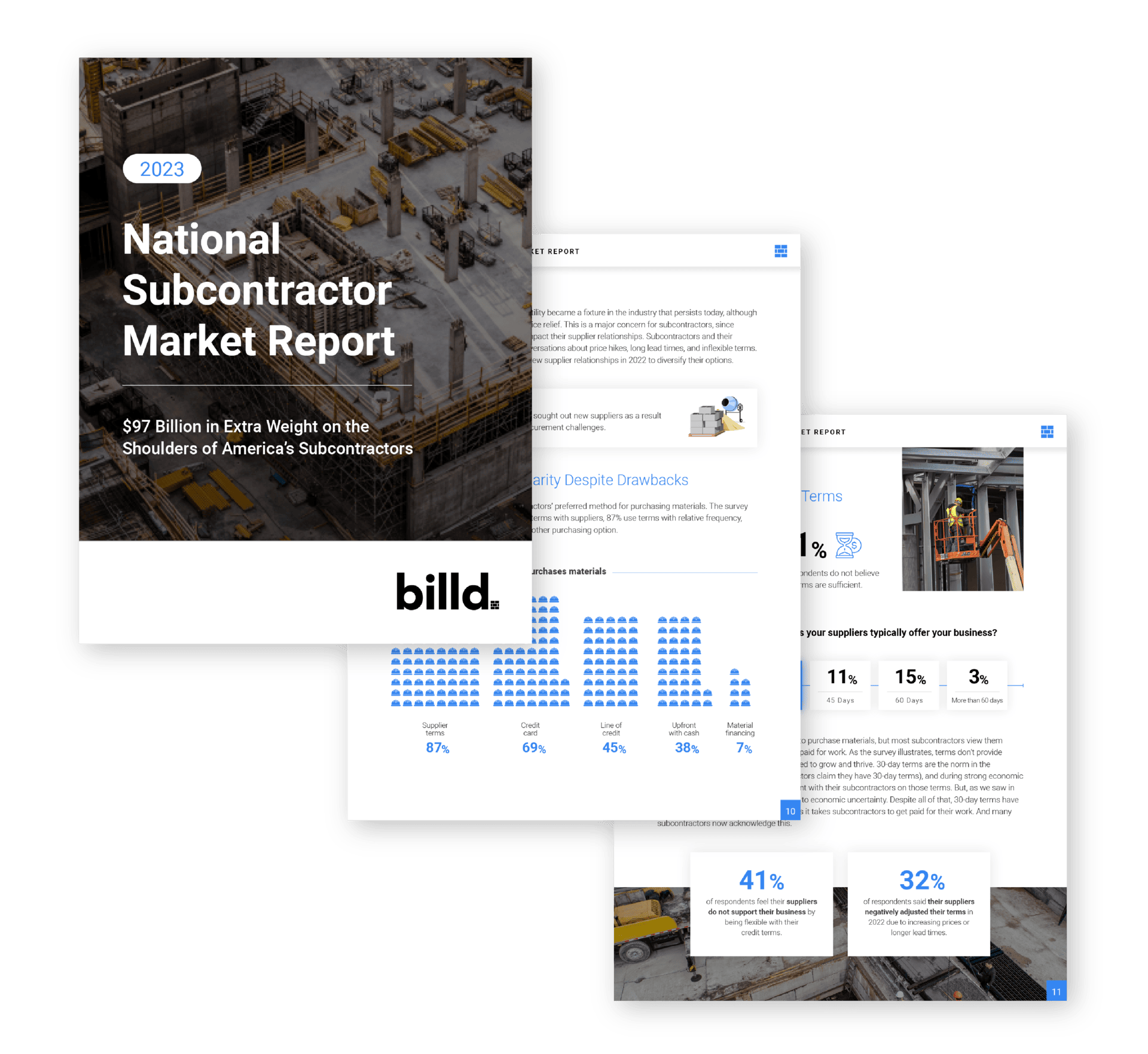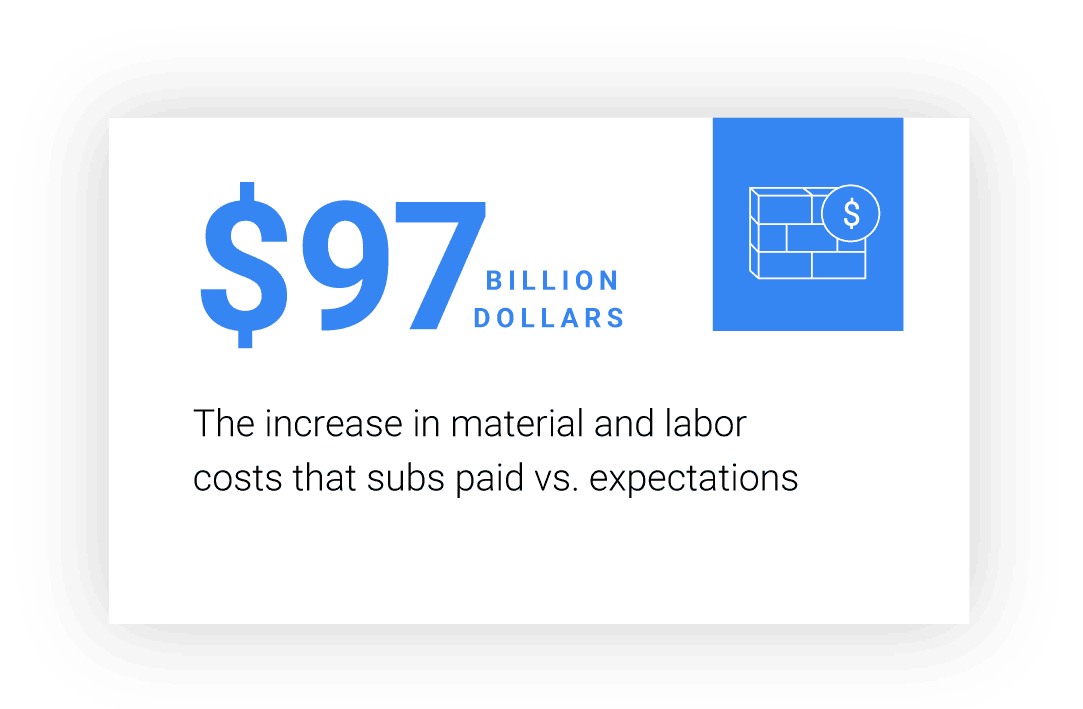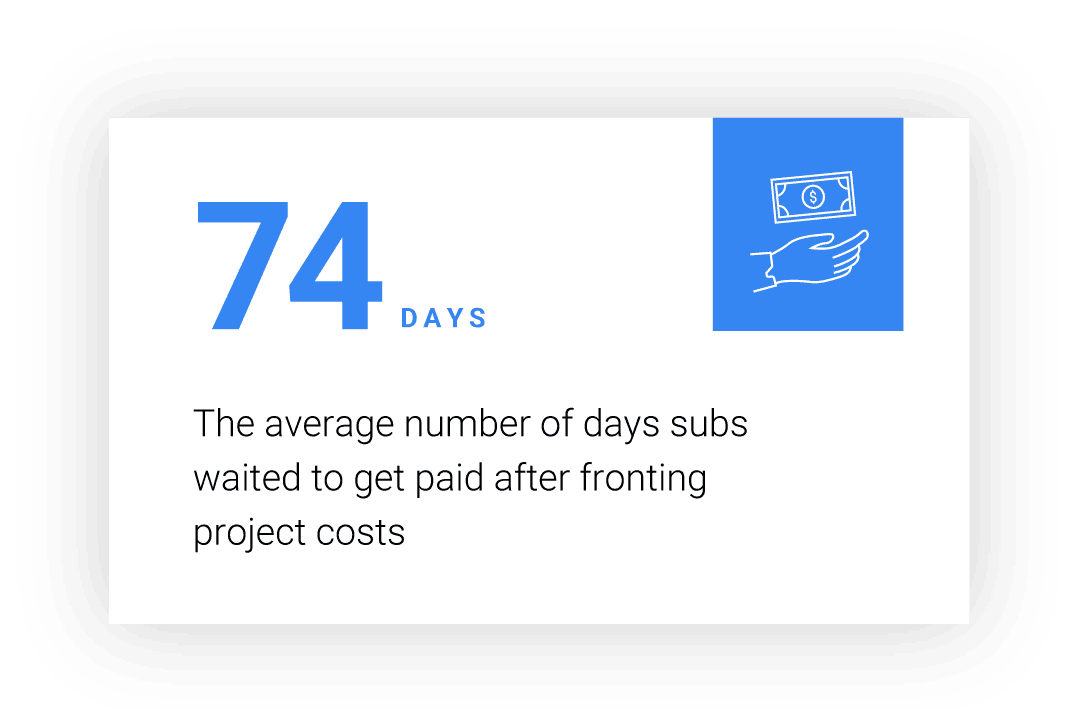By Billd

As the commercial construction industry continues to face challenges related to rising material costs and labor shortages, subcontractors find themselves bearing the brunt of these expenses. In its third annual construction industry market report, Billd reveals alarming statistics regarding the financial burden placed on subcontractors. The 2023 National Subcontractor Market Report sheds light on the significant additional costs incurred by subcontractors in 2022, amounting to a staggering $97 billion.
In this blog post, we will delve into the report’s key findings, explore the impact of rising costs on subcontractors, and discuss potential solutions for commercial developers navigating these challenges in the coming year.

National Subcontractor Market Report Shows Rising Input Costs
The first major challenge highlighted in the report is the substantial increase in material cost, which surged by 26% in 2022. Subcontractors, who largely front the costs of these materials, faced significant financial strain as a result. Moreover, the report reveals that 81% of surveyed subcontractors reported a negative effect on their businesses due to rising material costs. This upward trend is expected to persist, with 80% of respondents anticipating further increases in the coming year.
Furthermore, the construction industry continues to grapple with an unwavering labor shortage. Subcontractors saw an average increase of 15% in labor cost, intensifying the financial burden of their project staples. The shortage of skilled laborers and increased competition for available workers contribute to rising labor costs.
The total unexpected additional cost to subcontractors for materials and labor in 2022: $97 billion dollars.

Cash Flow in Jeopardy According to National Subcontractor Market Report
Because of the nature of the repayment cycle in construction, subcontractors covered the entirety of these costs (not just the overage) out of pocket before receiving payment. The average time from work commencement to payment is 74 days, with some waiting much longer than that. The resulting strain on their cash flow limits their ability to take on the projects they need for growth while impacting their ability to deliver committed projects on time and within budget.

Decline in Profitability
Despite efforts to mitigate the impact of rising costs, subcontractors faced difficulties in maintaining profitability. The report indicates that 57% of businesses reported a decrease in profitability, even though 61% experienced revenue growth. This discrepancy highlights the significant strain imposed on subcontractors’ margins. One contributing factor is the low-bid environment that subcontractors operate in; one-third of survey respondents were unable to raise their bids commensurate with their rising expenses. As a result, subcontractors were forced to absorb a substantial portion of the additional costs, further squeezing their profit margins.
How Commercial Developers Can Mitigate Risk
The findings of the 2023 National Subcontractor Market Report highlight not only the financial challenges subcontractors face but also the potential risks that commercial developers may encounter as a result. The increasing financial strain on subcontractors can have far-reaching consequences for successfully completing construction projects. It is essential for commercial developers to be aware of these risks and take proactive steps to mitigate them.
One of the primary risks faced by commercial developers is subcontractor default. When subcontractors face a significant financial strain, they may struggle to fulfill their contractual obligations, leading to delays in project schedules and increases in damages. To mitigate this risk, developers should work with general contractors to adopt strategies promoting financial stability and resilience for subcontractors.
One effective approach is to incorporate material price escalation clauses in contracts that pass through to subcontractors. These clauses ensure subcontractors are not solely responsible for bearing the full weight of material price increases. By ensuring these clauses apply to subcontractors, commercial developers can distribute the impact of rising material costs across all project stakeholders, reducing the financial burden on subcontractors and minimizing the risk of default.
Another crucial aspect is establishing transparent payment timelines and fast payment processing systems. Subcontractors heavily rely on timely payments to manage their cash flow effectively. By implementing efficient payment practices, developers can enable subcontractors to anticipate cash flow gaps and adjust their financial strategies accordingly. This may mean moving away from pay-when-paid clauses common in subcontracts, even though prime contracts are net-30 or net-45. This allows subcontractors to focus on delivering high-quality work without compromising their financial well-being.
Furthermore, commercial developers should consider working alongside general contractors to evaluate subcontractors’ financial health and stability during the selection process. By assessing subcontractors’ financial standing and access to financial resources, developers can make informed decisions that minimize the risk of subcontractor default. This evaluation can include analyzing subcontractors’ lines of credit, past financial performance, and ability to leverage third-party financial services if needed.

Taking a Proactive Approach for Sustainable Success
As the 2023 National Subcontractor Market Report reveals, subcontractors’ financial challenges in the commercial construction industry have significant implications for commercial developers. It is in the best interest of developers to acknowledge these risks and adopt a collaborative approach to ensure their projects’ long-term success and profitability.
By focusing on subcontractor performance and health, developers can address potential financial risks early, reducing the likelihood of delays, disputes, and compromised project quality.
Moreover, developers should consider working with general contractors to establish fair and transparent payment terms in the sub-contract that align with the needs of subcontractors. Timely and equitable payment practices contribute to subcontractors’ financial stability, enabling them to meet their obligations and deliver high-quality work.
In conclusion, the financial strain experienced by subcontractors poses inherent risks for commercial developers in the construction industry. By understanding these challenges and proactively mitigating them, developers can establish a collaborative and mutually beneficial ecosystem that ensures successful project completion, high-quality craftsmanship, and sustainable growth for all parties involved. Working hand in hand with project stakeholders, commercial developers can navigate the complexities of rising costs and financial pressures, ultimately achieving their project goals and contributing to a thriving construction industry.
Check out Biild’s video roundtable series, which is a conversation between a developer, general contractor, and subcontractor on topics including payment, quality, and scheduling: https://billd.com/roundtable
Billd stands alone as a partner that truly champions the subcontractor. Founders Christopher Doyle and Jesse Weissburg, industry veterans in both construction and finance, witnessed the detrimental impact to subcontractors of the longstanding broken payment cycle in construction. Their time in the trades inspired them to launch Billd in 2018, bringing the financial power of Wall Street to the construction job site. Billd’s financial and payment products empower subcontractors to bypass project hurdles by providing access to upfront funds to cover their most pressing costs, including materials and labor. Unlike traditional financing outlets, Billd provides flexible lines of credit to accommodate the unpredictability of cash flow in construction and extends their customers up to 120-day terms to align with industry payment standards. Billd knows traditional credit metrics are poor predictors for risk and has built a variety of industry-specific, proprietary analytic and financing tools to allow subcontractors to stabilize cash flow and more effectively grow their businesses.
Ready to Revolutionize the Construction Industry? Join CURT Today!
As we conclude this insightful journey into the world of capital assets and construction excellence, we invite you to take action and be a part of the transformation. CURT.org stands as a beacon for owners who strive to make the most of their capital investments.
Join CURT now to:
- Gain Aggressive Leadership: Be at the forefront of business discussions that shape the future of capital assets creation.
- Embrace Global Impact: Speak collectively for owners worldwide, influencing contractor and engineering matters.
- Unlock Unparalleled Resources: Tap into our extensive network and resources for driving continuous industry improvement.
Your participation can catalyze change and drive innovation across the construction landscape. Together, we can create a more efficient, productive, and sustainable future.
Visit CURT.org today and become a catalyst for industry-wide progress. Let’s turn your capital dollars into transformative results!
